Not one, but TWO wallaby joeys are starting to steal the hearts of every explorer in Australia Walkabout! Gidgee and her sister, Katt, are both carrying 5-month-old joeys who are starting to poke their heads out of the pouch, taking in the world around them. This is Gidgee’s third joey and Katt’s first. Both moms are doing well, adjusting to life with their little pink pouch occupants. The joeys are developing quickly, with their limbs, eyelashes, whiskers, and facial features becoming more distinct. Both joeys are likely to start exploring the yard on their own two feet around mid-April.
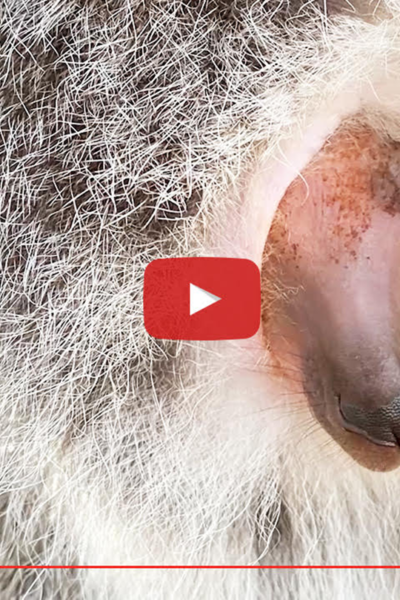

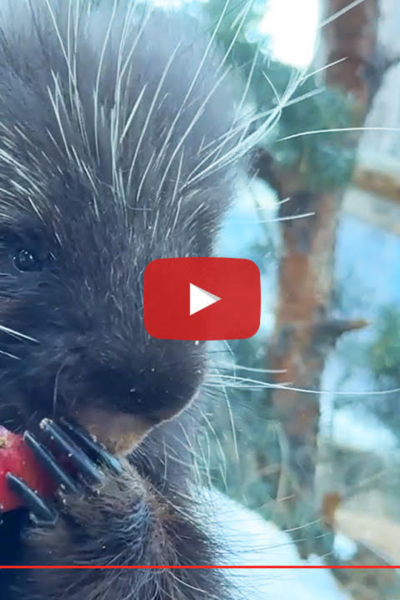

Roger, 4-year-old North American porcupine, has some impressive “quill-ities.” His gentle, curious and friendly nature directly contributes to Roger’s important training behaviors, adorable enrichment and strong relationship with his keepers. Mastering behaviors like target training, stationing and injection training plays a big role in how keepers can best care for Roger now and in the future. Visit Roger in Rocky Mountain Wild during your next visit to CMZoo!
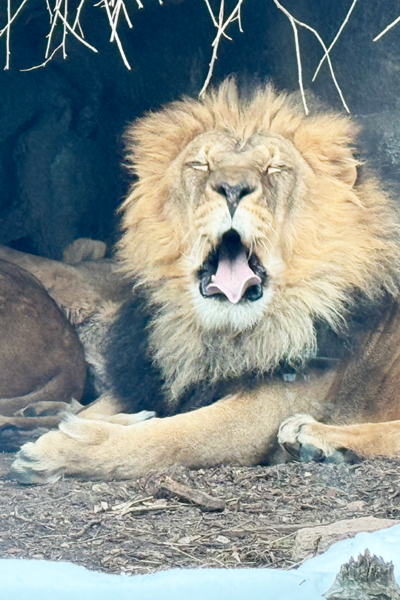

African lions are working through a delicate transition in African Rift Valley. The lion keepers’ long-term goal is to provide healthy groupings and vital social interactions for the four related big cats, with Lomela, the mother, bridging the gap for her family.
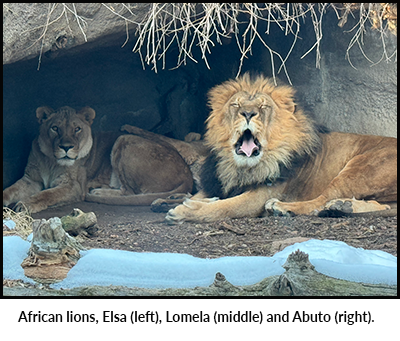
Aging parents, Abuto (12) and Lomela (16), their daughter, Elsa (8), and their son, Aslan (8), make up the African lion pride at Cheyenne Mountain Zoo. In April 2023, Aslan’s and Elsa’s brother, Boma, moved to San Diego Zoo Safari Park. When Boma and Aslan were about a year-and-a-half old, Abuto told them it was time to go on their own, so the boys formed a coalition and lived together. After Boma began showing signs that he was ready for his own pride last year, which is typical for male lions around that age, CMZoo worked with the Association of Zoos and Aquariums’ (AZA) African Lion Species Survival Plan to find Boma a pride of female lions to live with.
After Boma’s departure from CMZoo, the African lion care team began ‘howdies’ between Elsa and Aslan, so Aslan could have another lion to spend social time with. After their interactions with a protective barrier between them didn’t produce the outcome keepers hoped for, the team started weighing other options.
“We didn’t see anything necessarily alarming between Elsa and Aslan during their howdies, but we didn’t see the calm and interested behaviors we wanted to see,” said Savannah Woods, animal keeper in African Rift Valley. “Re-introducing lions can be dangerous. When you’re deciding whether to give these massive animals access to each other, you want to have the right indications that they’re going to be safe.”
The keepers’ next option was to see if Lomela and Aslan could be re-introduced. It wasn’t their first option because of Lomela’s age and the reality that she might not be around for a lot longer. She has reached the median life expectancy for African lions in human care, according to the AZA.
Lomela and Aslan started howdies a few months ago, and in early February, after seeing several good interactions, the two started sharing space.
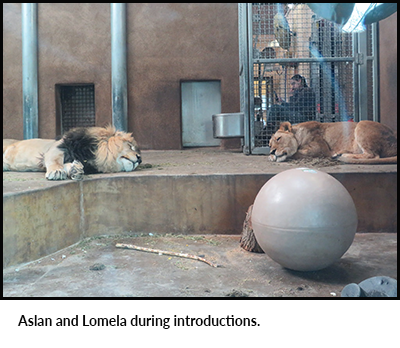
“Lomela is calm and assertive, which is what Aslan needs so he can re-learn what is acceptable behavior around female lions,” said Woods. “He is more interested in her than she is in him, so he’ll approach her to smell her, and she will let him get close until she decides she wants more space. Then, she’ll typically hiss or bark at him, and he will back off. He’s being respectful, and she’s communicating really well.”
As introductions continue, the mother and son have been comfortable sharing space. They’re often seen drinking water, engaging with enrichment individually and sleeping in separate areas of the same room, which are signs of comfort.
In a recent introduction, Aslan approached Lomela while she was lying down, and she hissed at him to give her more space. Because he’s getting more comfortable, he’s also testing new limits, and she is responding with new communication methods – in this case, a roar and a single swat to his face. He backed off right away, and they both laid back down. About 30 seconds later, Lomela moved closer to Aslan to get a drink of water, and he watched her calmly without moving. The two are continuing to learn how to interact in ways they’re both comfortable with.
“Their actions can seem a little intense sometimes, but that is just how they communicate,” said Woods. “We will have someone monitoring them during introductions, until we’re confident they’ve developed good social skills together. This new setup doesn’t come without risk, but we have to trust them to continue communicating because, long-term, having these social opportunities is best for the pride. We’re really proud of their progress, and glad we can provide new social opportunities.”
Because of Lomela’s age, keepers will continue to work on howdies between Elsa and Aslan. That plan will likely have Lomela sharing space with Elsa on one side of a protective barrier and Aslan on the other. Lomela’s presence is calming for Elsa, so keepers are leaning on Lomela to help her kids feel comfortable around each other. Unfortunately, aging Lomela won’t always be here to help her family get along, so they’re taking advantage of the time they have with her leadership.
“We’re grateful for Lomela’s leadership and we’re hopeful about the interactions we’ve seen so far,” said Woods. “We appreciate everyone sending the pride their best wishes as they move through these new chapters.”
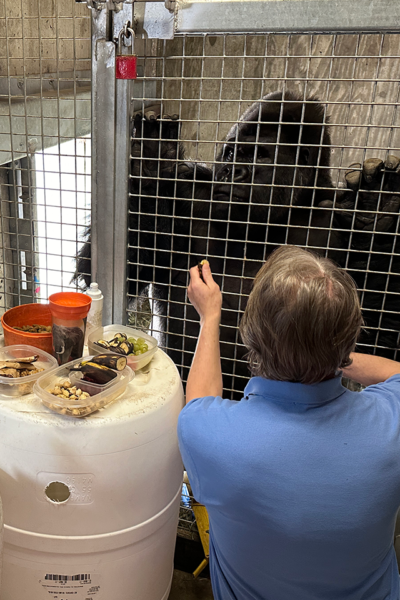

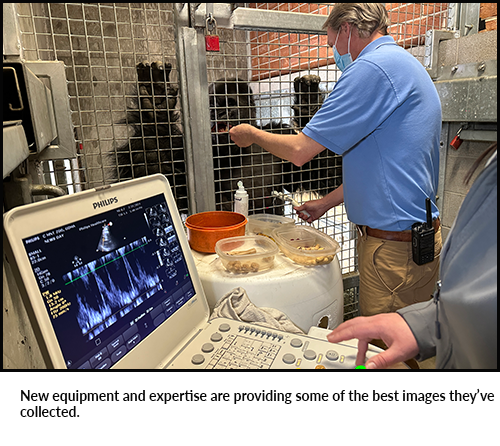
A charcuterie board fit for a king sits in the human side of a gorilla den. Peanuts, grapes, bananas, primate biscuits and handmade peanut butter-and-oatmeal roll-ups are lined up next to a souvenir CMZoo cup of juice, ready to reward an impressive set of skills. The goodies are for the king of Primate World – Cheyenne Mountain Zoo’s much-loved male Western lowland gorilla, Goma.
Just beyond the spread of sweet and savory snacks, on the gorilla side of the den, a blue plastic stool sits in a room covered in comfy hay with two open doors on either side. One brightly backlit door leads to the yard, where the sun is shining brightly on a warm February day. On the other side of the second door, CMZoo’s gorilla troop members, Asha, Kwisha, Roxie and Goma are lounging, foraging, building nests and interacting with guests through glass.
February is Heart Month and today is another heart health monitoring day, so a veterinary cardiologist is on site. Heart health is important regardless of age or species. CMZoo partner, Children’s Hospital Colorado, cares for some of the world’s smallest cardiac patients, while CMZoo cares for one of the biggest.
Goma will be 33 years old on March 31, and the median life expectancy for male Western lowland gorillas in human care, according to the Association of Zoos and Aquariums is 32.7 years. Unfortunately, heart disease is prevalent in older male great apes. Goma has heart disease and takes oral medication to prevent its progression. His disease is under control and his care team monitors his health with regular cardiac ultrasound readings provided by the local experts at North Springs Veterinary Referral Center.
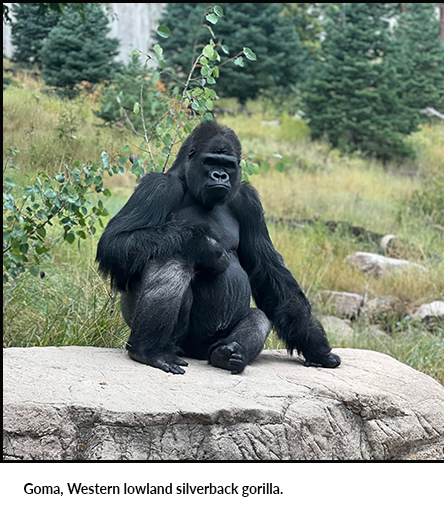
As the cardiologist follows Primate World Lead Keeper Jon Wild into the room, a commanding but tentative presence joins them from the other side of the mesh. It’s Goma, and he knows those tasty treats are for him.
“Hi there,” Wild says softly to the 435-pound silverback, who is taking his time scanning the room, his big brown eyes intently studying the faces beaming back at him. “We have some extra people in here today, don’t we? You’re okay. Do you want to come over here and do some ultrasound training with us? Just sit here on your stool, and we’ll get started.”
Goma isn’t hesitant about Wild, the cardiologist, the equipment or the observing keeper in the room. He’s familiar with this setup; he just did this a few days ago. It’s the two people here to learn about his training and take photos that he’s not so sure about. Wild reassures Goma, and Goma quickly settles onto his light blue spool seat, scooching up to the mesh for a refreshing gulp of juice.
Goma is comfortable, even with the new visitors, because his care team has earned his trust through years of relationship building. Goma established this ultrasound behavior previously, so once Goma got to know Wild, who has 22 years of experience working with great apes and has worked at CMZoo for over a year, they started building upon it. The most important part of Goma’s participation in the ultrasounds is sitting still – either on his stool or on the ground – with his chest close enough that Wild can slip the probe through the mesh onto Goma’s chest.
The sessions’ length is up to Goma. Sometimes they’re five minutes and sometimes they last over an hour. Wild communicates to Goma to reposition or to bring his chest closer to the mesh, and Goma sits still. Wild and the cardiologist communicate about the image on the ultrasound screen and where to move the probe to get the best views. All the while, Goma sits patiently and gets treats from Wild. But, there’s one element that sensitive Goma, who is a great student, isn’t shy about protesting.
“He doesn’t care for the ultrasound gel,” said Wild. “Some animals enjoy it and they rub it all over themselves, some don’t seem to notice, and Goma tolerates it, but not right away. We can’t figure out why. It doesn’t have a smell, and it isn’t menthol or textured. We warm up the gel so it isn’t cold. When he sees the gel bottle, he’ll lean slightly back and side-eye it until I present the best reward – his peanut-butter and oatmeal roll-ups or juice.”
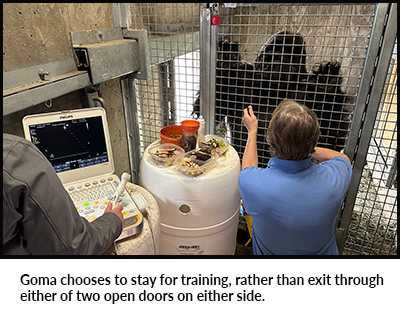
Once Goma agrees to let the gel touch his skin for the first time, he’s fine with it, but he is welcome to have a moment to communicate he’d rather not endure it at the beginning of each session. He’s a smart gorilla, and he negotiates throughout sessions. Sometimes he offers a more simple behavior compared to presenting his chest, like offering his shoulder or opening his mouth, to see if that will elicit a reward. If he wants to stop, he can always walk away, but that doesn’t happen often.
“We’re asking him to choose this over whatever he’s engaged in,” said Wild. “That’s why the high-value snacks are so important. The experience has to be his most rewarding option, which means having his favorite foods and knowing he’s in control. He also needs to be comfortable with the team. When we started working with this cardiologist, we introduced them while she gave him snacks and juice and talked to him so he could get used to her voice. We got lucky because Goma really likes her.”
His care team is excited about the images Goma has allowed them to collect on ultrasound. They say the equipment and expertise they have access to now is providing some of the best images they have been able to collect.
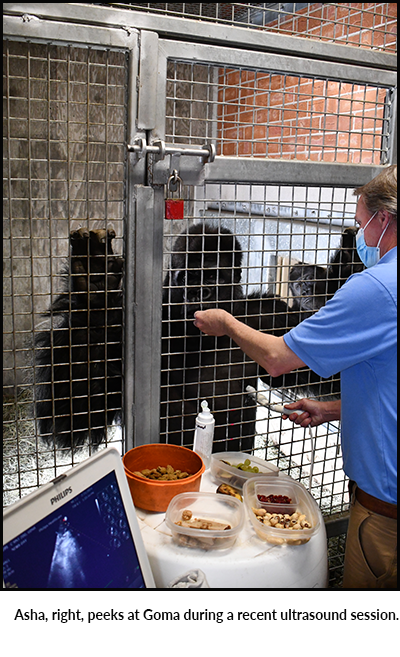
Making sure Goma’s medication is working is the top priority, but the images serve another purpose. CMZoo shares Goma’s heart health updates, images and medication regimen with the Great Ape Heart Project – a collection of great ape keepers and veterinarians who use this data to learn more about gorillas’ and orangutans’ hearts and share that with people who care for apes. That shared greater depth of knowledge can provide caregivers more treatment options and proven solutions for the great apes in their stewardship.
About 20 minutes into Goma’s session, another curious face appears in the room. This time, it’s not a person, it’s 31-year-old Asha, who is Goma’s number-one in the troop.
“She wants a turn,” said Wild, gesturing toward Asha. “Most of our great apes participate in some kind of heart monitoring, whether that’s EKG readings or blood pressure monitoring through their fingertips, or ultrasounds. Asha is also working on an ultrasound behavior on her belly.”
Asha, who has a breeding recommendation with Goma, is eager to train with Wild. But, Goma is the dominant animal in the group, so Asha doesn’t interfere beyond glancing toward Wild and Goma to make sure they have noticed her playing with a few little pieces of hay in the doorway to the den. Once Goma is finished training, Asha comes into the den and Wild places the probe on her abdomen, but doesn’t see anything exciting. Asha and Goma have been seen breeding, but there’s no evidence it has been successful.
CMZoo will continue to share updates as the group continues to train, bond and grow as a cohesive group.


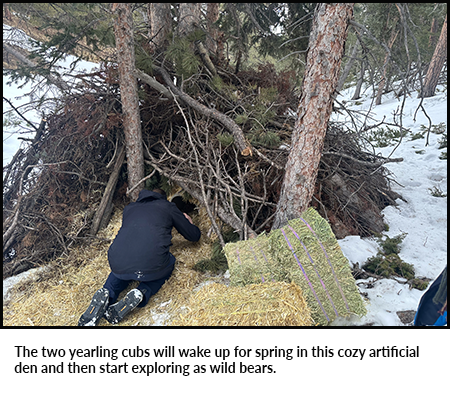
Through Cheyenne Mountain Zoo’s annual Member Conservation Vote, CMZoo members are funding an important ongoing study on the movements of wild black bears in the Pikes Peak region. In 2022, members voted to spend conservation-allocated membership revenue on GPS ear tags that Colorado Parks and Wildlife (CPW) officers use when reintroducing black bears to the wild.
In early February 2024, CPW transported two yearling black bear cubs that were fitted with the GPS ear tags from a rehabilitation facility to an artificial den on Pikes Peak. Later this spring, they’ll wake up and start their second chance at living wild.
According to CPW, one of the bears placed in the den this month was orphaned by its sow last summer in the Broadmoor neighborhood in southwest Colorado Springs – just down the road from CMZoo. The sow had four cubs, which is extremely unusual. CPW biologists speculate she may not have been able to care for all four cubs. It’s likely that as the runt of her litter, this little one was abandoned.
The other bear wandered into the Rifle Falls Fish Hatchery without its sow last summer. It would not have been able to survive on its own in the wild at that young age, so it found a home as a surrogate sibling with the ‘Broadmoor Bear’ at the rehabilitation center.
Both cubs, about a year old now, spent the last several months together, being kept as wild as possible in preparation for their reintroduction. Earlier this month, CMZoo staff joined CPW to observe their journey back to the wild.
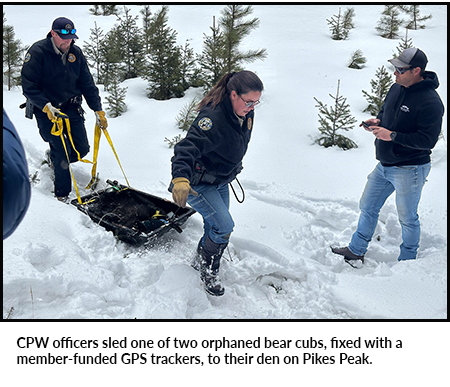
“CPW officers pulled the little bears – who were under anesthesia – on sleds through the snowy evergreen forests on Pikes Peak and tucked them into a nice warm den,” said Zwicker. “They’ll stay in this den for the rest of winter, and then they’ll wake up and start helping their species by giving us a glimpse into their whereabouts over the next several months.”
The GPS data uploads from the ear transmitter tags about every two weeks. CPW tracks those snapshots of the bears’ locations to help define successful rehabilitation and care for orphaned bear cubs, and where to release them.
This is the second time member-funded GPS trackers have been used to track black bear movements after wild reintroduction. The first two cubs with these ear tag transmitters were released in January 2022 to the same artificial den.
One of the 2022-released bears dropped its ear tag several months after waking up in the den, as planned, and by all accounts is still living wild on the mountain. The other unfortunately reoffended and had to be euthanized after human-wildlife conflicts.
“It’s a sad fact, but it’s also a stark reminder that we need to help bears stay out of trouble,” said Zwicker. “With this data from the GPS trackers, biologists will be able to compare what four cubs do in the same space. They can look at the rehab strategies used for each and compare their success as wild bears. It’s going to help us help more wild bears stay wild.”
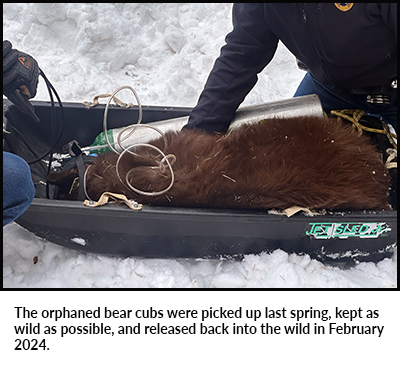
CPW reports that urban bear conflict is one of their biggest issues, especially bears getting into garbage at area homes and businesses. It will be valuable to study the effectiveness of rehabilitation efforts with orphaned bear cubs and see if they really do learn to avoid humans in the future. Zwicker urges Coloradans to be good neighbors of native wildlife by following simple ‘bear aware’ guidelines.
“Working with CPW on projects like this has enhanced my understanding of the natural world,” said Zwicker. “The folks at CPW truly care about wildlife. They’re incredibly dedicated and impressive professionals fighting the good fight for our local wildlife. Our roles can be different, but we’re all passionate stewards of our environment. I’m grateful our members are funding this connection between the Zoo’s animal advocates and the animal advocates at CPW.”
Since 2015, the Member Conservation Vote has provided $600,000 of membership revenue to support field conservation worldwide. Each year, a total of $100,000 of membership revenue supports conservation projects in two ways:
- $25,000 to the Quarters for Conservation program, which has raised more than $5 million dollars for CMZoo’s legacy conservation projects since the program began in 2008.
- $75,000 to projects voted for by CMZoo members through this annual vote.
Next month, CMZoo members will get the opportunity to vote on the 2024 Member Conservation Vote projects. Members, keep an eye on your email for your members-only link to vote! Interested in becoming a member? Visit cmzoo.org/membership.
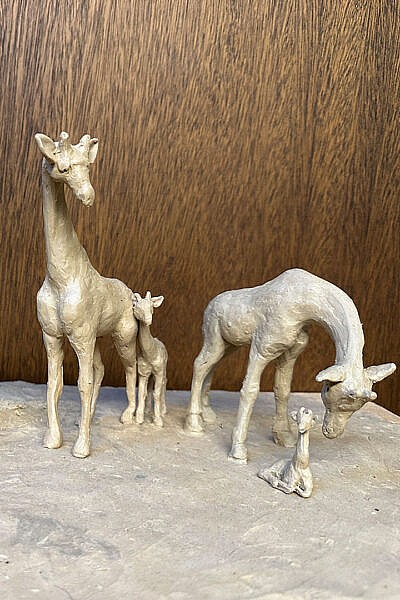

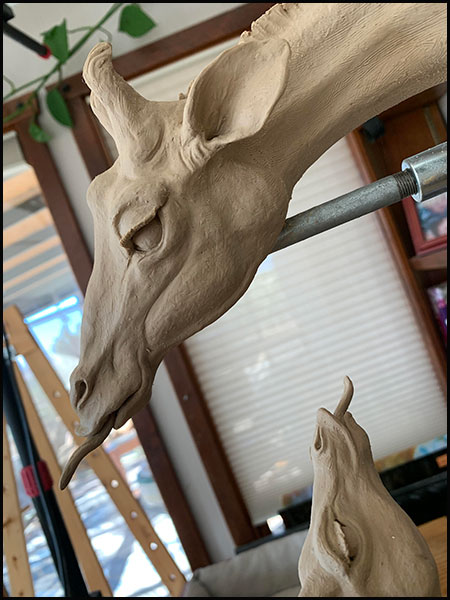
Six life-sized bronze giraffe sculptures will welcome guests to Cheyenne Mountain Zoo, as part of the new admissions and giraffe habitat updates happening in the coming years – and their creation is a tall order.
“I’ve been using a lot of ladders,” said Antonia Chastain, public art manager at CMZoo. “These are the largest sculptures I’ve ever done, and it’s quite a process. We have probably years ahead of us in this creation. But it’s exciting to see the first one coming together now, and the plan is to unveil them as part of the hundred-year anniversary of the Zoo, in 2026.”
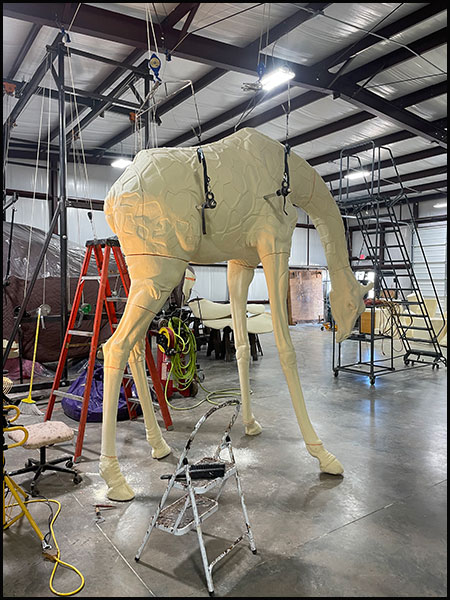
The sculptures started as six-inch clay thumbnail sketches. Once the team was happy with the general design, Chastain sculpted detailed four-foot clay maquettes. To create the most lifelike sculptures, she relied on the expertise of the giraffe team to portray giraffe attitudes and postures correctly.
Chastain spends weeks with the CMZoo giraffe team, leaning on the giraffe herd’s voluntary hoof care behaviors to measure the giraffe. They measure from hoof to knee, around the diameters of their calves, the lengths of their tails, legs, necks and more, to get the proportions right in the maquettes phase. Known for her attention to detail, Chastain also meticulously studied and sculpted eyelid wrinkles, hair, hoof texture, spots and skin folds.
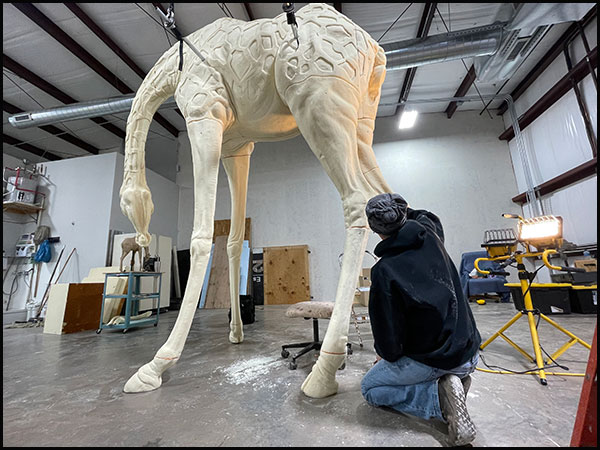
“Then, you need to make sure the four-foot models’ knees and ankles are proportional, because if you enlarge them to five times the size for the final sculptures, you could end up with knees that look like elephant knees above ankles made for giraffe,” said Chastain. “It’s so important that the proportions are correct.”
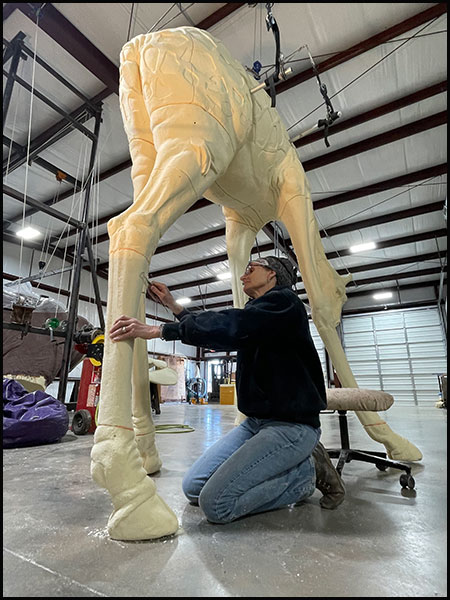
To create the next size up, the foundry artists scan the four-foot clay models into a 3-D printer that produces foam pieces five times their size – one piece at a time. The foam pieces are reconstructed into a life-sized full giraffe, then Chastain reapplies a layer of clay to the huge replicas. Once every detail is carved back into the clay, the team casts each piece in bronze and welds them together.
The one being sculpted in its final size now is posed bending down to nuzzle her calf, and she is ten feet tall at the curve of her neck. The other mother giraffe sculptures are posed more upright, and will be around 18 feet tall when they’re finished.
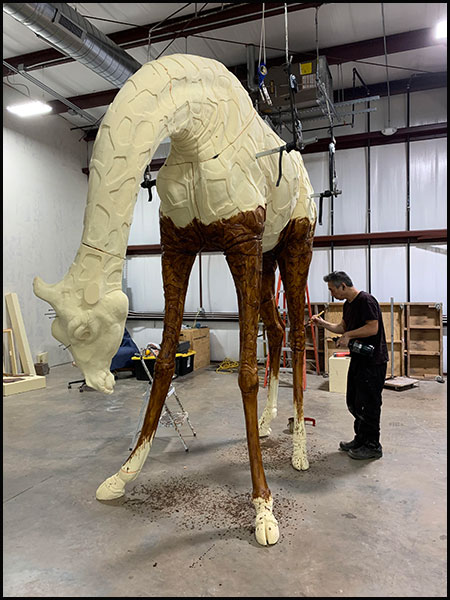
As of now, the plan is to create three visual stories of mother giraffe and their calves. The statue of Penny, a giraffe calf who inspired millions during her short life at CMZoo, will move from its current location by the giraffe barn to become part of this larger display. The three mother giraffe and two additional giraffe calf statues are not representations of any individual giraffe. However, especially attentive giraffe fans might notice spot patterns, poses or ossicone shapes inspired by other giraffe from CMZoo.
“The various poses are homages to their nurturing instinct and the special connection between mother and baby,” said Chastain. “One set is stretching towards each other to nuzzle face-to-face and there’s a line between their necks that’s just beautiful form and flow. The third pair is a nod to when kids are little and they’re shy to meet someone new. Their instinct is to lean against mom for security, kind of a ‘hold my hand’ feel.”
As the sculptures continue to take shape and eventually make their way to the Zoo, CMZoo will share updates.
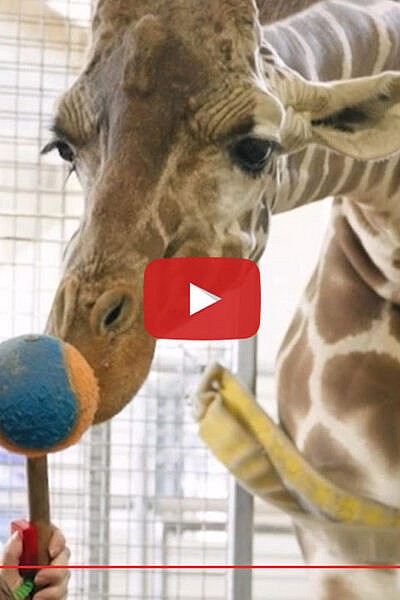

February is International Hoof Care Month, so come behind the scenes for an up-close look at giraffe hoof care training! Hoof care is important for the overall health of all hoofstock animals. Brushing, picking, and trimming contribute to maintaining healthy hooves, directly influencing the health of a giraffe’s entire body. At CMZoo, keepers have built trust with the giraffe herd through positive reinforcement, offering them the choice to train with their favorite crackers or walk away.
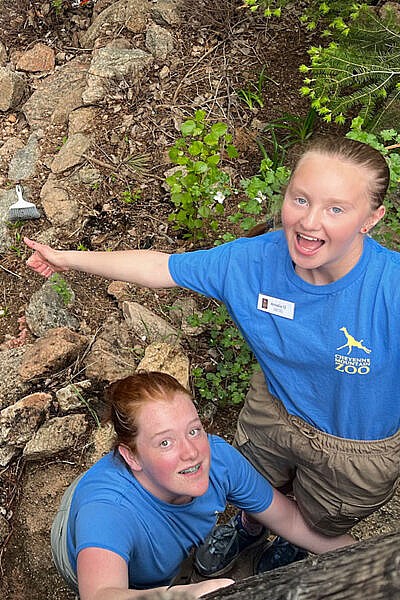

Cheyenne Mountain Zoo’s Teen Summer Program has inspired and prepared future biologists and conservationists for decades. Soon, it will welcome new and returning participants for summer 2024. Applications for the highly competitive program for sixth through 12th graders open Thurs., Feb. 1 at cmzoo.org/teenprograms. Applications will only be accepted for two weeks, so nature-loving teenagers should start considering the program now.
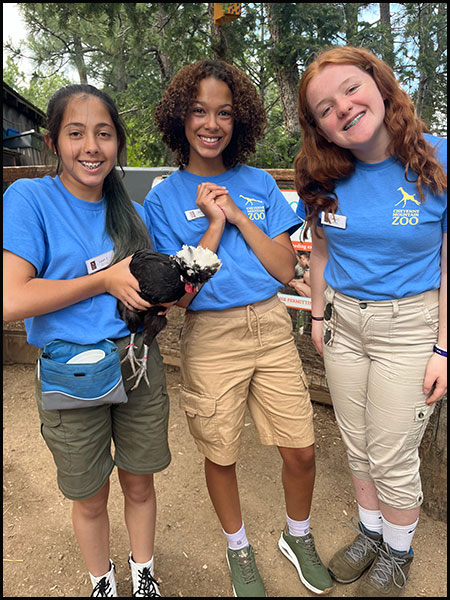
From Mon., May 27 through Fri., Aug. 9, 2024, Teen Summer Program participants will work alongside CMZoo staff to interact with animals, guests, keepers and each other. Mabel Kim has been in the Teen Program since the summer before her high school freshman year, and in 2024, she intends to come back for her fourth year.
“Some might assume the Teen Program at the Zoo is all about animals, but it’s one of the richest experiences like this you can get in Colorado Springs,” said Kim. “I’ve learned presentation skills, public speaking, mentoring, writing a resume, interviewing and more. It’s a really fun environment, and we do focus on animals and conservation. Because of this program, I feel prepared to apply for college, internships and jobs.”
In addition to gaining valuable experience working at CMZoo, teen participants learn to be nature’s best stewards with life-changing experiences off Zoo grounds, in Colorado’s wild places and beyond. Teens can expect educational, inspirational experiences, like whitewater rafting, camping, rock climbing, mountain biking, visiting local animal sanctuaries and Associations of Zoos and Aquariums-accredited zoos, and learning to be a leader and an advocate for wildlife and wild places.
“Ultimately, we hope that by offering these experiences that connect the hands, the heart, and the mind to the natural world, these teens will stand up for, and advocate for, the wild places and wild animals of our world,” said Austin Kennedy, CMZoo Extended Education Supervisor. “We focus on leadership training, animal husbandry, interpretation and public speaking, empowerment, and so much more.”
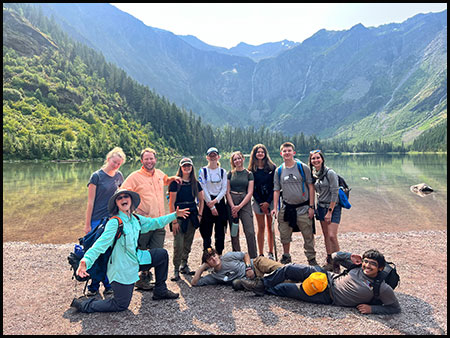
Participants also have the chance to go on an EdVenture Trip with the team, led by EdVenture staff. In 2023, the teens embarked on a six-day off-grid adventure to the wilderness of Glacier National Park. [LINK TO: https://www.cmzoo.org/news/archive/teen-program-inspires-the-next-generation-of-land-and-wildlife-stewards-in-glacier-national-park/] This year, managers are planning for another excursion full of adventure and nature-inspired leadership learning.
“I can’t encourage people enough to apply,” said Kim. “Definitely go for it. You’ll have amazing opportunities with animals, but you’ll also learn real-life and career skills. Plus, you’ll form bonds and make friendships with people who have similar interests, like science, nature, conservation and advocacy.”
EdVenture staff recommends each teen commits to a minimum of 120 program hours for the season. However, to complete the program, there is no minimum or maximum number of participation hours required.
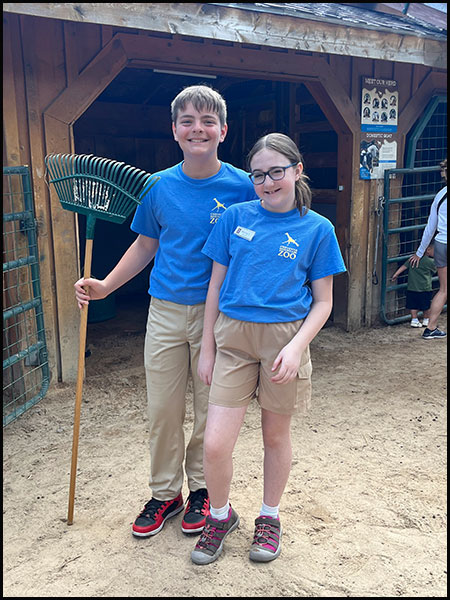
Applications are open Thurs., Feb. 1 until Wed., Feb. 14 at midnight MT. The non-refundable application fee is $25, and no late applications will be accepted. Typically, only one-third of those who apply will be accepted.
After the application period, EdVenture staff conducts interviews with candidates, and ultimately accepts about 100 teens to the summer program. CMZoo’s Teen Summer Program is a tuition-based experience, and scholarships are available. Participation in EdVenture trips requires a separate fee.
If a summer timeline won’t work, consider participating in an off-season Teen Program. The Teen Winter Program runs November through February, with applications opening for two weeks each October. The Teen Spring Program is only open to teens who have participated in a Teen Summer or Winter Program. The spring session runs February through May, with applications opening for two weeks each January.
For more information – and to apply between Feb. 1 and 14 – visit cmzoo.org/teenprograms.
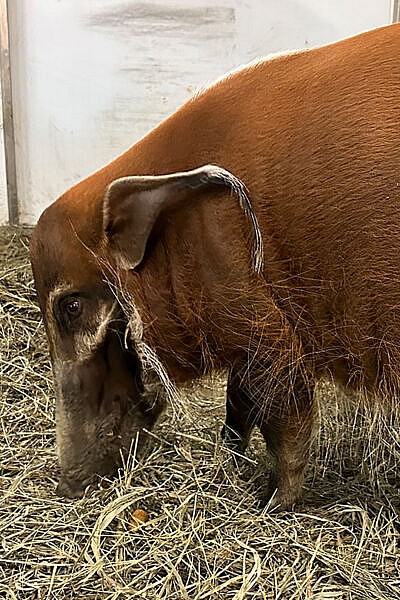

Two redheaded charmers from Texas arrived in African Rift Valley earlier this month, complete with gorgeous ear tassels and pointy hooves. While they complete their routine quarantine period behind the scenes, Red River hog sisters, Rey and Finn, are cooing their way into the hearts of their keepers. Hopefully, the Zoo’s male Red River hog, Augustus, will be just as excited to welcome them to the family.
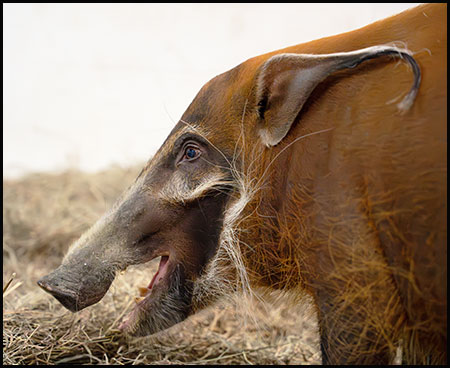
After their quarantine, they’ll start exploring more spaces and getting to know 17-month-old Augustus, known as “Gus” around here. In the meantime, keepers are getting to know the girls.
“They’re gorgeous animals, and these two are extremely vocal,” said Lauren Phillippi, lead animal keeper in African Rift Valley. “They have been making quiet, content ‘cooing’ sounds to each other and to us when we approach them. They like to do things together, like forage, solve puzzle feeders, roll around in the hay and snuggle while they sleep.”
The 7-year-old sisters were born in the same litter at another zoo accredited by the Association of Zoos and Aquariums. Rey is the leader of the two, and she is a bit bigger than Finn. Rey has darker orange-brown coloration compared to Finn’s much lighter white-and-brown face. Finn is a little more cautious. Being bold and outgoing, Rey is quick to approach keepers, wasting no time to communicate that she is a big fan of belly rubs.
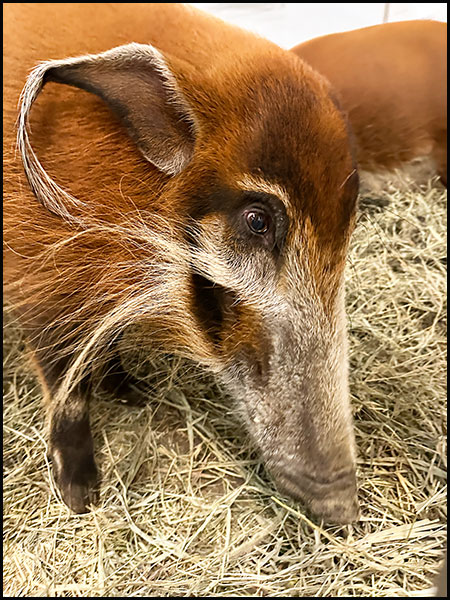
“We quickly noticed how tactile these two are,” said Phillippi. “They enjoy enrichment that requires a lot of motor skills, and they like to get scratches from keepers. Especially Rey.”
Keepers use wooden back scratchers and their hands to give Rey the tactile interaction she likes. Just a few seconds into a scratch session, 165-pound Rey gives an enthusiastic lean and a floor-shaking plop onto her side. She knows how to give keepers every opportunity to scratch her sides, belly and back. Her care team is happy to oblige.
“We’re using this time to develop relationships with them,” said Phillippi. “We want to build that rapport and make sure they know that they’re going to live with choice and control here.”
Finn and Rey are already willingly approaching keepers and staff from behind a protective barrier. They’re also taking training treats well and moving to different spaces when asked. Next, keepers will work on target training and then more complex voluntary behaviors that allow them to care for the girls.
The big question: when will the sisters meet Gus? Finn and Rey are used to sharing space with other hogs, as is Gus. Once the sisters have completed quarantine, the team will introduce the group with a protective barrier between Gus and the girls. Then, based on the hogs’ behaviors toward each other, they’ll move towards sharing space without barriers between them.
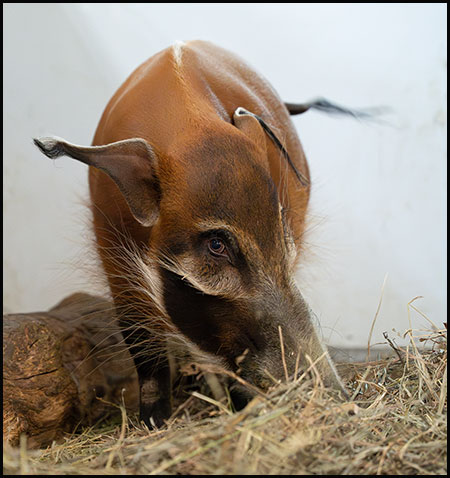
The goal is for all three hogs to live together full-time. Red River hogs are social animals, often living in groups, and Finn and Rey came to CMZoo on a breeding recommendation with Gus. At 17 months old, Gus is approaching the age when Red River hogs typically reach reproductive maturity. Red River hogs’ usual breeding season ends in April, so depending on their interactions and Gus’ maturity, hoglets could be here as soon as this summer. More likely, their first chance at reproducing will be next year.
If the hogs eventually welcome babies, all three would be first-time parents, making their genetics valuable to the Red River Hog Species Survival Plan and the population in human care.
When Finn and Rey are ready to explore spaces where guests can see them, the Zoo will provide updates.
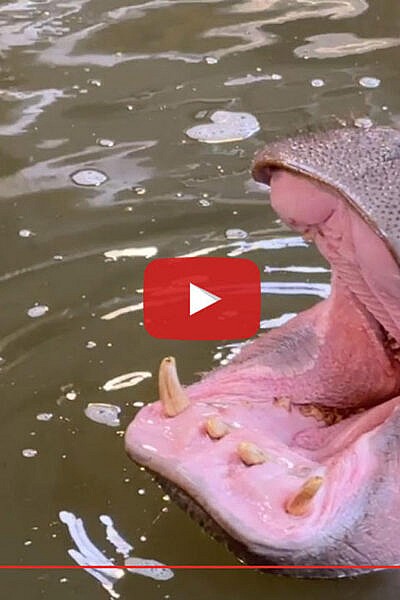

Rambunctious ‘Baby’ Omo has discovered little joys like the feeling of the hose on his gums and the excitement of exploring on his own while still living under the protective eye of his mom, Zambezi. At two and a half years old, Omo is learning and refining foundational training behaviors while also regularly getting the zoomies.
Omo and Zambezi still live together full time but are working on training in different spaces with the doors open between them. With a 1,300 pound ‘hippo tween’ always at the ready to play, Zambezi continues to nurture and teach her wiggly son while recently discovering the little joys of solo time. This time allows Zambezi and Omo some one-on-one time with their care teams and the opportunity to learn, grow, and rest in different ways.